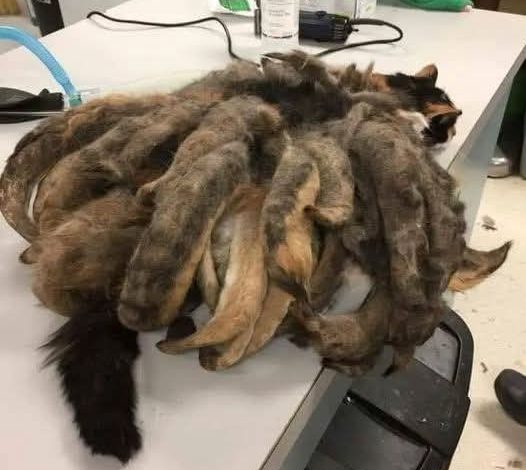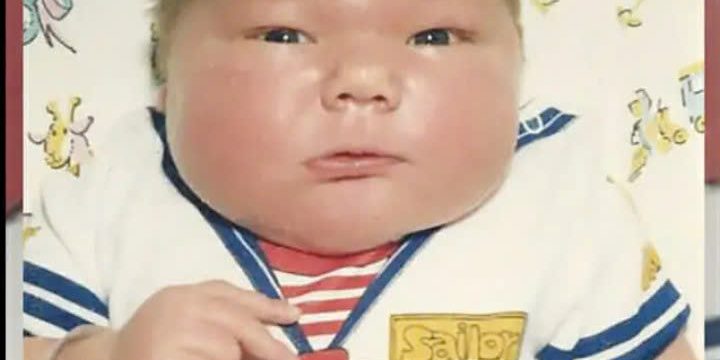Cats have a reputation for being independent creatures—animals that wander freely outdoors, nap wherever they please, and return home mostly for food, affection, or a warm place to rest. Their self-sufficient nature often makes them seem like the easiest pets to care for. But even the most independent cat still needs basic grooming, monitoring, and regular attention from the people who love them. When that care disappears, the consequences can be heartbreaking. Hidey, a sweet cat whose life unexpectedly spiraled into neglect, became a powerful example of this truth.

Hidey lived with an elderly owner who was quietly battling Alzheimer’s disease. As the condition progressed, responsibilities that once felt simple—such as brushing a beloved pet—became increasingly difficult. Over time, the decline in her owner’s memory and abilities left Hidey without the care she desperately needed. No one realized just how severe the situation had become until the cat was finally rescued.
When responders from the Pittsburgh Animal Rescue League Shelter and Wildlife Center first laid eyes on Hidey, they were stunned. Her thick fur had become so severely matted that she appeared to have long, rope-like growths trailing from her body. Some of the mats resembled tangled tentacles, giving her an almost unrecognizable silhouette. Those who found her later said the sight was so startling that they needed a moment to process what they were seeing.
After arriving at the shelter, staff estimated that Hidey might not have been groomed in as long as two years. In some areas, her matted fur had grown to an unbelievable six to eight inches, heavy enough to restrict her movement and cause discomfort with every step. It was clear she had been suffering silently for far too long.
Thankfully, Hidey’s story took a turn for the better as soon as she reached safety. Veterinarian Jenn Levitzki, who was part of the team caring for her, was shocked by the extent of the matting. “Hidey has the worst matting I have ever seen; she has dreadlocks,” Jenn wrote on Facebook, sharing a video of the delicate grooming process. To keep her calm and comfortable, Hidey was gently sedated before the team began removing the dense, tangled masses that weighed down her small body.
Piece by piece, the medical team worked carefully to free her from the mats. With each cut of the clippers, pounds of excess fur fell away. Beneath the knots and tangles was a cat who had likely forgotten what it felt like to move freely. When the process was complete, Hidey emerged transformed—not just physically, but emotionally. A weight had literally and figuratively been lifted from her life.
The shelter later shared an update online saying, “Undoubtedly, this cat is feeling so much better now that our medical team shaved pounds of tangled fur off her body!” Their post quickly gained attention, with people expressing relief, sympathy, and gratitude that Hidey had received the help she needed.
After her recovery, Hidey was placed with a distant relative of her former owner—a loving person who understood her past and was committed to giving her a safe, stable future. Her new home offered not only comfort, but also the consistent care she had been missing for so long. It was the beginning of a peaceful chapter in a life that had once been marked by confusion and neglect.
But while Hidey’s transformation is heartwarming, it also highlights a deeper message—one that reaches far beyond a single rescue story. Her experience serves as a gentle reminder of how important it is to stay connected to our aging relatives, neighbors, and community members. As people grow older or face health challenges, they may struggle quietly, unsure of how to ask for help or unaware of how much their daily routine has slipped from their control.
When seniors live alone, even small responsibilities can become overwhelming. Tasks like cleaning, grocery shopping, managing medications, or caring for pets may fall through the cracks long before anyone realizes something is wrong. And when these changes go unnoticed, both the individual and their animals can suffer unintentionally.
Hidey’s story encourages us to pay closer attention—to visit more often, check in regularly, and offer help when we can. A simple conversation, a brief visit, or a quick observation could make all the difference in spotting early signs of struggle. By reaching out, we create opportunities to protect not only the well-being of elderly loved ones but also the pets who depend on them.
This event also reminds us that compassion extends in many directions. The people who cared for Hidey stepped in to provide medical treatment, love, and safety, embodying exactly how communities can work together when someone is vulnerable—whether human or animal. When we look out for one another, we create safer, kinder environments for everyone.
Hidey’s journey—from neglect to healing—may have started with heartbreak, but it ended with hope. Her transformation serves as a gentle reminder that with a little awareness, empathy, and timely support, we can prevent suffering and create brighter futures for those who cannot speak for themselves. And sometimes, the simplest act—checking in on someone—can change a life in ways we never expect.





